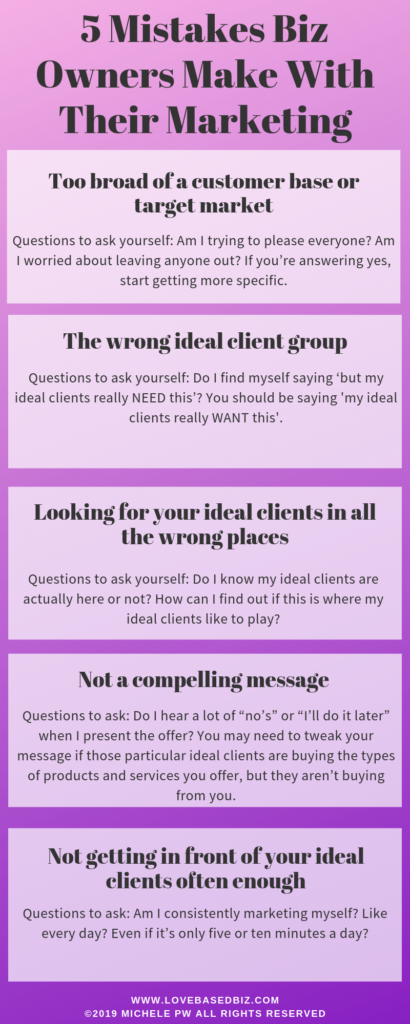I’ve been knocking around the online industry for well over a decade, and none of the marketing mistakes I bring up in this post are new.
But it IS important.
So, I thought I’d create a handy little cheat sheet for you to use every time you’re feeling stuck.
Fortunately (or unfortunately, depending on how you look at it), many marketing-related challenges can be traced back to a handful of basic marketing mistakes. Today, I’m covering five of the top ones I see business owners make.
Marketing Mistakes #1: Too broad of a customer base or target market (who you’re selling your product or service to).
If I ask you who your ideal client is, and you answer, “anyone with a pulse,” I’m talking to you.
Even if your product or service CAN help just about anyone on the planet, not everyone is going to buy it. They don’t have the money or the interest or the whatever. And when you try and target everyone, you really end up targeting no one.
The way to start making money (not to mention getting better results from your marketing) is to narrow your customer base, so you’re only talking to one specific group of people (your ideal clients).
However, there are pitfalls with that as well (see mistake two).
Questions to ask yourself to avoid this mistake: Am I trying to please everyone? Am I worried about leaving anyone out? Do I think I’ll lose money if I narrow my focus to clients I love? (Note: If you’re answering “yes” to any of these, start drilling down and getting more specific.)
Marketing Mistakes #2: The wrong ideal client group.
What do I mean by “wrong” ideal clients? Well, they’re wrong for you if they’re not interested in buying your product or service, or if they are otherwise just not a good fit.
Let’s look at the “not interested” group.
In the health and wellness field, where I see this mistake a lot, it typically goes something like this:
You are passionate about teaching yoga, and you want to reach committed couch potatoes.
Do committed couch potatoes need to be doing yoga? No question.
Do they want to be doing yoga? Probably not, or they wouldn’t be committed couch potatoes.
What happens here is the word “need” is often misused. “I know my ideal clients need this, therefore they’ll buy it.” Not so.
Now, let’s look at the “otherwise not a good fit” group. Chances are, this group will likely exhibit some form of “not valuing” what you offer—which sometimes hides behind “can’t afford” it language.
People are surprisingly resourceful, so just because it looks like a particular group can’t afford something on the surface, it doesn’t mean it’s true. Sometimes entrepreneurs attract a whole bunch of freebie seekers who say they can’t afford their products or services. Whether or not that’s true is debatable; what isn’t debatable is that they clearly don’t value what is being offered enough to figure out a way to invest in it.
Bottom line—make sure you choose ideal clients who both want AND value your product or service.
Questions to ask yourself to avoid this mistake: Do I find myself saying, “But my ideal clients really NEED this”? (Note: The more you focus on “need” versus “want,” the more likely it is that you’re trying to force your offerings down an unwilling customer group’s throat.)
Marketing Mistakes #3: Looking for your ideal clients in all the wrong places.
“Build it and they will come …” Or not so much.
Once you know who your ideal clients are, you need to go to them. And you shouldn’t waste your time in places where you won’t find them.
Let’s say your ideal clients are Fortune 500 companies. Is hobnobbing at your local Chamber of Commerce going to pay off for you? Probably not. Buying a targeted list and putting together a direct mail campaign? Much better idea.
Or, for instance, a few years back a friend of mine switched her online business to target a different customer group, only to discover that particular group didn’t spend much time online. Needless to say, that wasn’t a good fit, and she quickly pivoted back to her original ideal client group.
But it doesn’t always look that drastic. Sometimes, it’s just a matter of picking the wrong social networking platform. For instance, advertising on Facebook versus Instagram. I’ve known entrepreneurs who, for the life of them, couldn’t make Facebook advertising pay off for them, but Instagram worked like a charm.
Once you’ve selected a viable ideal client group, make sure you’re putting your marketing time and dollars into places where they hang out.
Questions to ask yourself to avoid this mistake: Do I know my ideal clients are actually here or not? How can I find out if this is where my ideal clients like to play?
Marketing Mistakes #4: Lack of compelling message.
Okay, so what if you know you’ve got a good ideal client group, and you know how to reach them, but you’re still not getting any results? It’s time to look at your message.
People have a lot of choices when it comes to where they spend their money. So naturally, you have to give them a very compelling reason why they should spend their hard-earned money with you.
And that’s why it makes sense to brush up on your copywriting skills (writing promotional copy), or to hire someone to write your copy for you.
Questions to ask yourself to avoid this mistake: Do I hear a lot of “no’s,” in response to your offer? How about “I’ll do it later,” or, “I can’t afford it?” Maybe “I don’t have time right now”? (Note: You’ll also often hear these same objections if you’re trying to market to the wrong ideal client group. One way you can tell the difference is if you can figure out if these particular ideal clients are buying the types of products and services you offer, but just not from you.)
Marketing Mistakes #5: Not getting in front of your ideal clients often enough.
So you’ve run one ad. Or made one phone call. Or attended one networking event. And the work isn’t pouring in the door.
Hmmm …
It’s a sad fact that you need to consistently get in front of your ideal clients time and time again. Unfortunately, for the most part, your ideal clients won’t wake up and say, “Gee, I have to give so-and-so some money today” without some encouragement on your part.
Remember, it’s not your ideal clients’ job to remember you. It’s your job to remind them you’re there and would love to have their business.
Questions to ask to avoid this mistake: Am I consistently marketing myself? Like every day? Even if it’s only five or ten minutes a day? Are there things on my to-do list I know I need to do, like write a blog post or send an email, that I never get to? (Note: Nuff said. You know if you’re consistently marketing yourself or not.)
 If you liked this post, you may also like my Love-Based Online Marketing book. You can learn more and get your copy here.
If you liked this post, you may also like my Love-Based Online Marketing book. You can learn more and get your copy here.

 10 Things to Consider Before Launching a Writing Business
10 Things to Consider Before Launching a Writing Business How the Pandemic Helped Me Stop Worrying and Start Writing
How the Pandemic Helped Me Stop Worrying and Start Writing 7 Tips for Launching a Copywriting Business
7 Tips for Launching a Copywriting Business The Importance of Personality Part 2: Let’s Add It to Your Writing
The Importance of Personality Part 2: Let’s Add It to Your Writing The Importance of Personality Part 1: Is Your Website Dreadful?
The Importance of Personality Part 1: Is Your Website Dreadful?
Leave a Reply